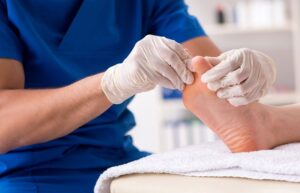Foot problems may seem minor, but they have a significant impact on a person’s quality of life. Special attention, coupled with appropriate care, is essential to prevent and treat these conditions. It is always advisable to consult a health professional for a diagnosis and treatment adapted to each case. Here are 8 common problems related to foot health.
1. Nail and skin fungus
Fungal infections, such as onychomycosis (nail fungus) and athlete’s foot , are common fungal infections. They manifest as thickened and yellowing of the nails and itching and redness between the toes. Treatment involves topical or oral antifungals, but prevention is key, including keeping feet dry and avoiding sharing shoes.
2. Hallux valgus (bunions)
Hallux valgus , commonly known as a bunion, is a deformity of the big toe. This painful condition, often hereditary, is exacerbated by wearing narrow, high-heeled shoes. Treatments vary from the use of orthopedic insoles to surgery in the most severe cases.
3.Heel spurs and plantar fasciitis
These conditions are related to heel pain. Heel spurs are bony growths, while plantar fasciitis is inflammation of the plantar fascia. Both can be caused by excess weight, prolonged standing, or improper footwear. Rest, stretching, and special insoles are often recommended.
4. Corns and calluses
Corns and calluses are thickenings of the skin, often painful, resulting from repeated friction and pressure. They usually appear on the toes and sole of the foot. Their treatment involves wearing suitable shoes and in some cases podiatric care to remove these growths.
5. Sprains and fractures
Feet are also susceptible to sprains and fractures, especially in athletes. These injuries require prompt diagnosis and appropriate treatment, which can range from rest to surgery to rehabilitation.
6. Diabetic foot
People with diabetes are at risk of developing foot complications ( diabetic foot ), such as ulcers and infections. Prevention involves careful control of diabetes, regular foot care and wearing appropriate footwear.
7. Flat foot
Flat feet is a condition in which the normally curved arch of the foot is collapsed or absent. This means that all or most of the sole of the foot touches the ground when a person is standing. Flat feet can be congenital (present from birth) or develop over time due to factors such as age, injury, being overweight, or medical conditions such as diabetes and rheumatoid arthritis.
Symptoms vary between individuals. Some people feel no pain at all, while others may experience pain in their feet, ankles, knees, or back. Treatment depends on the severity and associated symptoms. It may include orthopedic shoes , insoles, strengthening exercises, or in extreme cases, surgery.
8. Hollow foot
Pes cavus is characterized by an excessively high arch in the foot. This condition can be hereditary or the result of neurological disorders, muscular conditions, or other pathologies. Unlike flat feet, pes cavus focuses more pressure on the heel and forefoot.
People with cavus feet may experience pain, instability, and difficulty finding comfortable shoes. Due to the uneven distribution of pressure on the foot, they may also develop other problems such as calluses, heel pain, frequent ankle sprains or neuropathies.
Treatments for pes cavus may include foot orthotics to distribute pressure more evenly across the foot, suitable shoes, physical therapy exercises, and, in more severe cases, surgery to correct the structure of the foot.
The podiatrist, foot specialist
Are you experiencing foot pain? A podiatrist is a health professional responsible for foot health. He can evaluate and treat all foot diseases that are not caused by pathologies of the general organ system. He has the skills and training to conduct examinations and diagnose various foot diseases.





















+ There are no comments
Add yours